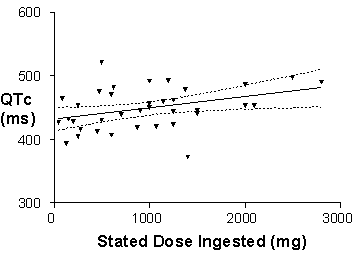| pA2 online © Copyright 2004 The British Pharmacological Society |
209P
GKT, University of London Winter Meeting December 2003 |
|
Electrocardiograph
and haemodynamic changes in thioridazine and chlorpromazine overdose |
|
Thioridazine is known to be associated with QT prolongation at therapeutic dose and this may result in sudden death (Reilly et al., 2000). We have examined the relationship between stated dose of thioridazine ingested in overdose and cardiovascular effect to explore the dose response relationship. Similar data was collected for chlorpromazine as the comparator phenothiazine.
Methods: A retrospective study of case records of patients presenting to the Edinburgh poisons treatment unit over a three-year period was carried out. Data on patient age and gender, the drug(s) ingested; the stated dose; maximal perturbation in heart rate and blood pressure; and on ECG parameters (QT, QTc, QRS PR) from computer generated ECG traces (Hewlett-Packard PageWriter XLi) were entered into a spreadsheet. Over the three-year period 96 patients with thioridazine, and 224 with chlorpromazine overdose were admitted. We excluded patients co-ingesting other cardio active agents and those in whom data was missing. We have carried out linear regression analysis to examine the relationship between stated ingested dose and effect.
Results: Of 96 patients (39 males, mean age 34.4 ±11.4 years) with thioridazine poisoning, 36 met entry criteria. In these patients heart rate ( p<0.001, r2=0.259) and QTc ( p=0.026, r2=0.137) (figure 1) were significantly correlated with dose of thioridazine . Other ECG parameters and the mean blood pressure showed no significant correlation. Of 224 patients (60 male, mean age 35.0±12.0 years) with chlorpromazine poisoning 96 met entry criteria. There was no significant, correlation between ECG parameters and stated ingested dose, however, a significant relationship between heart rate (p=0.011, r2=0.543) and stated ingested dose was found.In conclusion we have confirmed a relationship between thioridazine dose in overdose and QTc, but not found this to be the case for chlorpromazine. This data suggests chlorpromazine may have a more favourable ECG profile than thioridazine in overdose. No patients in this series suffered Torsade.

Figure 1 Relationship between stated thioridazine dose (mg) and QTc (ms) in overdose (n=36; y=0.0175x + 431.1; r2=0.137; p<0.026).
Reilly, J.G. Ayis, S.A. Ferrier, I.N. Jones, S.J. Thomas, S.H.L. (2000). QTc-interval abnormalities and psychotropic drug therapy in psychiatric patients. Lancet., 355 1048-1052.